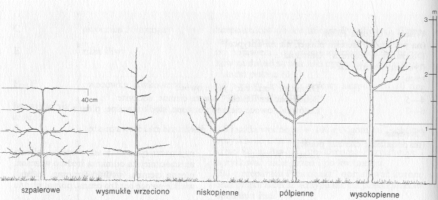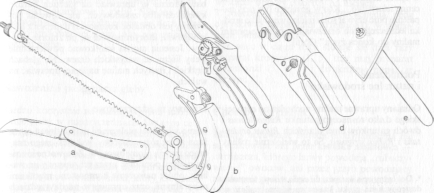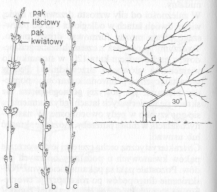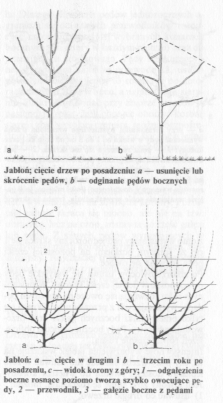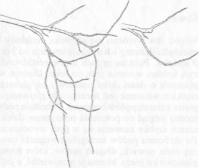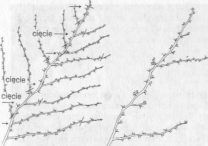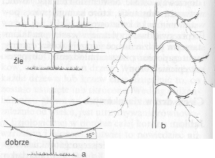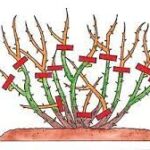Już w starych podręcznikach sadownictwa pisano o konieczności regularnego cięcia wszystkich drzew owocowych. Przez kilka lat nie cięte drzewa lub krzewy dziczeją i dają małe owoce, gorszej jakości, a także stają się podatniejsze na choroby i szkodniki. Dla uzyskania zdrowych i pełnowartościowych owoców konieczne jest coroczne, właściwe cięcie zarówno drzew, jak i krzewów owocowych. Korony młodych drzew, które nie były cięte zaraz po posadzeniu, wymagają istotnych poprawek, starsze zaś z różnych powodów potrzebują całkowitego lub częściowego przeszczepiania. Drzewom rosnącym zbyt silnie i osiągającym zbyt duże rozmiary trzeba obniżać korony i skracać gałęzie. Należy systematycznie usuwać gałęzie chore i uszkodzone, np. przez grad, wichury, niską temperaturę oraz choroby i szkodniki. Starzejące się drzewa wymagają silnego odmłodzenia korony. Po mocnym skróceniu starych gałęzi, mniej więcej do połowy korony, na konarach wyrastają silne, młode pędy.
Drewno jest kapitałem drzew i krzewów owocowych, odsetkami są owoce. Dlatego też bardzo ważna jest właściwa opieka nad każdym drzewem i krzewem od momentu posadzenia aż do późnego wieku, z uwzględnieniem cech wzrostu oraz specyficznych wymagań różnych gatunków, odmian i form drzew. Warto wiedzieć, że każde drzewo lub krzew chce uzupełnić to, co zostało usunięte lub skrócone. Według Hilken-baumera głównym zadaniem cięcia drzew, niezależnie od wieku, jest utrzymywanie równowagi fizjologicznej w obrębie całej korony między wzrostem i plonem. Łatwiej to powiedzieć niż wykonać. Problemy zaczynają się już przy formowaniu koron. Bardzo często zbyt wiele gałęzi zwisających lub rosnących w pozycji pionowej utrudnia dostęp światła do wnętrza korony, powodując tym samym zamieranie owocujących krótkopędów. Podobnie reagują drzewa zbyt gęsto posadzone.
W ostatnich dziesięcioleciach kilkakrotnie zmieniały się w sposób istotny metody cięcia drzew. Tworzono najróżniejsze formy — od naturalnych do sztucznych. Na skutek tak częstych zmian zalecenia głoszone przez fachowców nie zawsze znajdowały uznanie u sadowników. Mimo tych trudności doświadczony sadownik wie, w którym miejscu należy skrócić pęd jednoroczny. Trzeba uwzględnić przy tym różnicę długości między pędami liściowymi a owoconośnymi u poszczególnych gatunków roślin sadowniczych oraz różnice w czasie przekształcania się pędów liściowych w owoconośne. U wiśni, brzoskwini czy winorośli okres ten trwa zazwyczaj dwa lata. U jabłoni okres rozwoju pędów owoconośnych, wyrastających na przewodniku, trwa około trzech lat. Na początku tego stulecia w hrabstwie Kent w Anglii opracowano metodę cięcia polegającą na skracaniu pędów jednorocznych, zwaną metodą Pillara. Dziś nazywa się to także formowaniem wrzecionowym.
Prawidłowe formowanie korony trzeba zacząć zaraz po posadzeniu drzewa. W pierwszym roku formuje się pierwsze piętro korony z trzema pędami bocznymi luźno rozmieszczonymi na przewodniku. W następnych latach nadal formuje się koronę, a kiedy drzewa rozpoczną owocowanie, zaczyna się cięcie odmładzające i sanitarne. Cięcie odmładzające ma zasadniczy wpływ na coroczne tworzenie się pąków kwiatowych, również na tych pędach, na których rosną i dojrzewają owoce, bowiem dojrzewający owoc wytwarza substancje, które hamują proces powstawania pąka kwiatowego.
Po przerwie dwu-trzyletniej wyrastają na takim starszym pędzie owoce gorszej jakości; można temu zapobiec przez odmłodzenie lub przeszczepienie korony.
